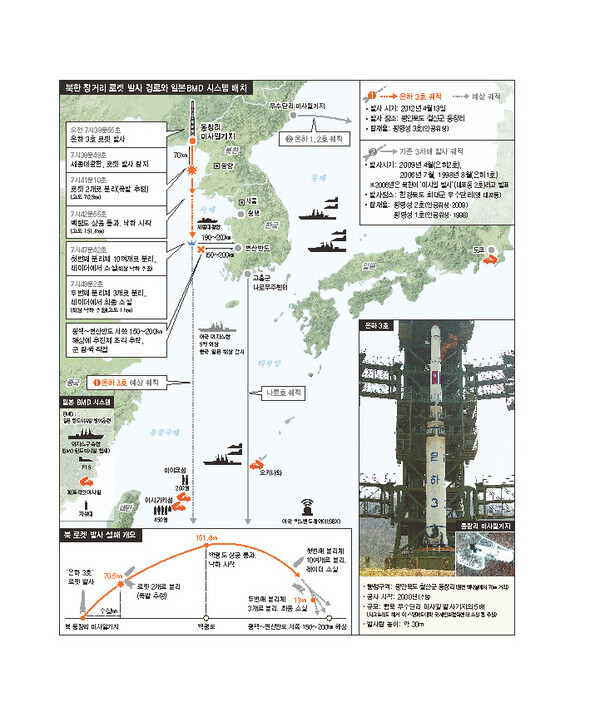hankyoreh
Links to other country sites 다른 나라 사이트 링크
Remnants of failed rocket lie in murky legal waters

By Lee Soon-hyuk, staff writer
The Unha-3 rocket broke apart into more than 20 pieces after a series of explosions and fell into the Yellow Sea, prompting South Korean military authorities to begin an immediate search for the debris.
The recovery effort should be feasible as the waters in the Yellow Sea are fairly shallow, with an average depth of roughly 30 meters. Regardless, experts expect the effort to use a considerable amount of manpower and equipment.
Also, the situation could cause controversy in terms of international law, since the waters the debris fell into are part of a South Korean exclusive economic zone (EEZ) but are not territorial waters.
South Korean military authorities immediately sent in the submarine rescue ship Cheonghaejin, which had been on standby. A minesweeper and agents from the Ship Salvage Unit were dispatched to the waters 100 to 150 kilometers west of Pyeongtaek and the Byeonsan Peninsula. The Cheonghaejin ship has a deep submergence rescue vehicle capable of carrying people and observing the ocean floor. The side scan sonar on the minesweeper is also to be used in searching for debris.
The military found some materials on the surface immediately after beginning its search of the waters where the debris is believed to have fallen. Ministry of National Defense spokesman Kim Min-seok said, “The floating matter appears to be missile debris. There may be additional floating matter in the water, but it may take some time to find it,” Kim added. “It is the ocean, after all.”
Observers in and around the military said private pair trawlers like those used in the recovery effort after the Cheonan sinking may also be sent in if the debris search and gathering effort proves beyond the capabilities of military equipment.
Another hurdle to the collection effort is the fact that North Korea’s ownership of the debris may be recognized by international law if it fell in international waters. This means it may not matter if the debris is picked up from international rather than territorial waters.
Inha University law school professor Lee Seok-woo, a specialist in international law, said, “The finder can exercise [ownership] rights first when something falls in international waters, but if the owner requests its return, they probably will have to give it back, while receiving compensation for the collection costs.”
However, there is some room for argument, given that the North Korean rocket launch was in violation a United Nations Security Council resolution, and the waters where the debris fell were part of a South Korean EEZ. Also, it may not be possible to claim that all ordinary international norms apply, since North and South Korea are still in a ceasefire.
“It’s difficult to give a precise answer, since there is virtually no precedent for this kind of thing,” said Cho Jung-hyun, a research fellow at the Korea Institute for National Unification’s North Korean human rights center and specialist in international law.
“A claim of ownership on the debris would be unusual, and since it fell in a South Korean EEZ, North Korea will argue strongly for a return, which would be unlikely to gain any legal legitimacy,” Choi said.
Kim Hyun-soo, an Inha University law school professor specializing in international law, said, “Since North Korea has ownership of the booster, it could ask for its return, but the South Korean government could also present its content as evidence of a North Korean provocation or demand an apology.”
Please direct questions or comments to [english@hani.co.kr]
Editorial・opinion
![[Column] Park Geun-hye déjà vu in Yoon Suk-yeol [Column] Park Geun-hye déjà vu in Yoon Suk-yeol](https://flexible.img.hani.co.kr/flexible/normal/500/300/imgdb/original/2024/0424/651713945113788.jpg) [Column] Park Geun-hye déjà vu in Yoon Suk-yeol
[Column] Park Geun-hye déjà vu in Yoon Suk-yeol![[Editorial] New weight of N. Korea’s nuclear threats makes dialogue all the more urgent [Editorial] New weight of N. Korea’s nuclear threats makes dialogue all the more urgent](https://flexible.img.hani.co.kr/flexible/normal/500/300/imgdb/original/2024/0424/7317139454662664.jpg) [Editorial] New weight of N. Korea’s nuclear threats makes dialogue all the more urgent
[Editorial] New weight of N. Korea’s nuclear threats makes dialogue all the more urgent- [Guest essay] The real reason Korea’s new right wants to dub Rhee a founding father
- [Column] ‘Choson’: Is it time we start referring to N. Korea in its own terms?
- [Editorial] Japan’s rewriting of history with Korea has gone too far
- [Column] The president’s questionable capacity for dialogue
- [Column] Are chaebol firms just pizza pies for families to divvy up as they please?
- [Column] Has Korea, too, crossed the Rubicon on China?
- [Correspondent’s column] In Japan’s alliance with US, echoes of its past alliances with UK
- [Editorial] Does Yoon think the Korean public is wrong?
Most viewed articles
- 1‘We must say no’: Seoul defense chief on Korean, USFK involvement in hypothetical Taiwan crisis
- 2N. Korean delegation’s trip to Iran shows how Pyongyang is leveraging ties with Moscow
- 346% of cases of violence against women in Korea perpetrated by intimate partner, study finds
- 4[Column] Park Geun-hye déjà vu in Yoon Suk-yeol
- 5‘Weddingflation’ breaks the bank for Korean couples-to-be
- 6Will NewJeans end up collateral damage in internal feud at K-pop juggernaut Hybe?
- 7Amnesty notes ‘erosion’ of freedom of expression in Korea in annual human rights report
- 8[Interview] Dear Korean men, It’s OK to admit you’re not always strong
- 9Korean government’s compromise plan for medical reform swiftly rejected by doctors
- 10[Editorial] Japan’s rewriting of history with Korea has gone too far